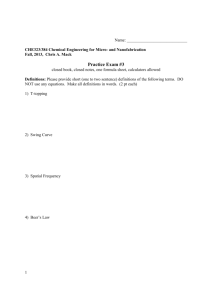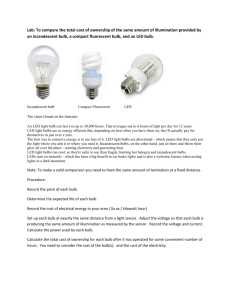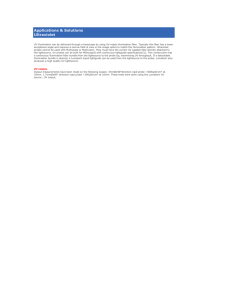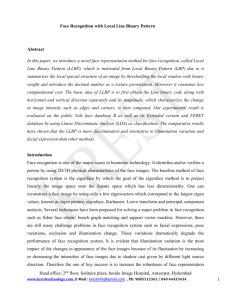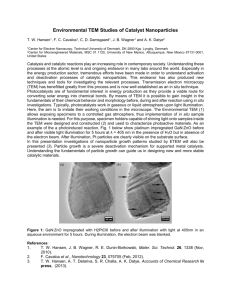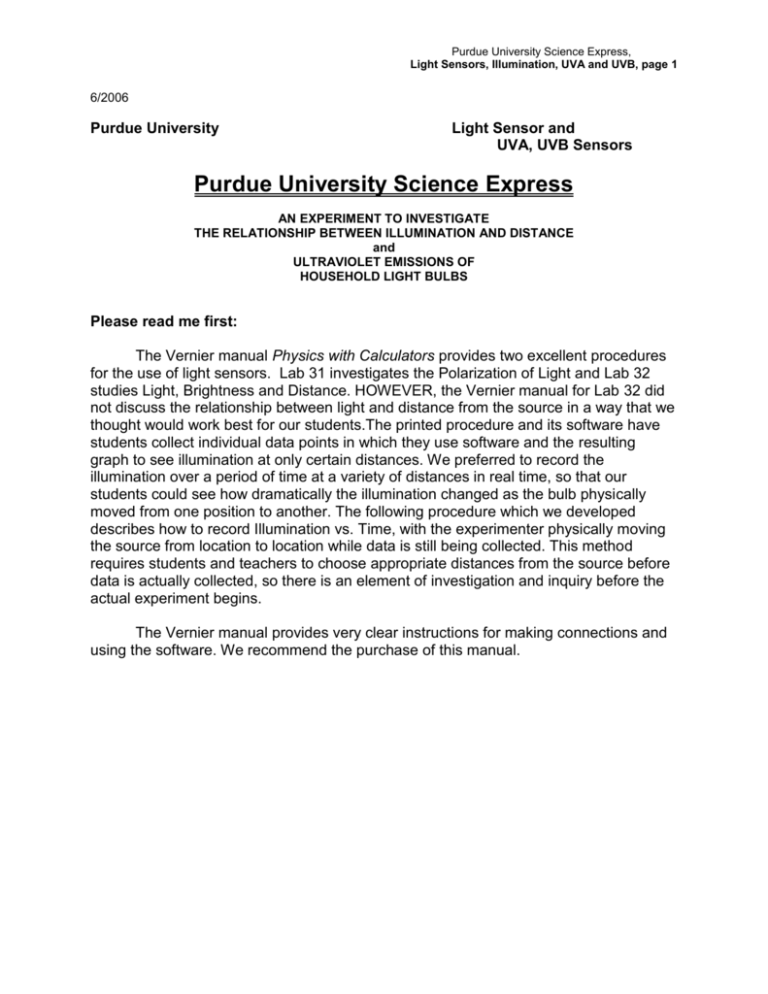
Purdue University Science Express,
Light Sensors, Illumination, UVA and UVB, page 1
6/2006
Purdue University
Light Sensor and
UVA, UVB Sensors
Purdue University Science Express
AN EXPERIMENT TO INVESTIGATE
THE RELATIONSHIP BETWEEN ILLUMINATION AND DISTANCE
and
ULTRAVIOLET EMISSIONS OF
HOUSEHOLD LIGHT BULBS
Please read me first:
The Vernier manual Physics with Calculators provides two excellent procedures
for the use of light sensors. Lab 31 investigates the Polarization of Light and Lab 32
studies Light, Brightness and Distance. HOWEVER, the Vernier manual for Lab 32 did
not discuss the relationship between light and distance from the source in a way that we
thought would work best for our students.The printed procedure and its software have
students collect individual data points in which they use software and the resulting
graph to see illumination at only certain distances. We preferred to record the
illumination over a period of time at a variety of distances in real time, so that our
students could see how dramatically the illumination changed as the bulb physically
moved from one position to another. The following procedure which we developed
describes how to record Illumination vs. Time, with the experimenter physically moving
the source from location to location while data is still being collected. This method
requires students and teachers to choose appropriate distances from the source before
data is actually collected, so there is an element of investigation and inquiry before the
actual experiment begins.
The Vernier manual provides very clear instructions for making connections and
using the software. We recommend the purchase of this manual.
Purdue University Science Express,
Light Sensors, Illumination, UVA and UVB, page 2
6/2006
Purdue University Science Express
AN EXPERIMENT TO INVESTIGATE
THE RELATIONSHIP BETWEEN ILLUMINATION AND DISTANCE
and
ULTRAVIOLET EMISSIONS OF HOUSEHOLD LIGHT BULBS
INTRODUCTION:
Which is a better purchase--a 25 W compact fluorescent bulb or a 25 W
incandescent bulb? Which provides more light onto your desk? Which costs more to
operate? Does either bulb emit harmful ultraviolet radiation? Which generates more
waste heat as infrared radiation? These questions should concern smart shoppers and
consumers. And the answers to those questions depend upon your needs and lifestyle.
Illumination on a surface like a table or desk is measured in units called lux while
the brightness of the source itself, the intensity, is measured in units called lumens. In
detail, 1 lux = 1 lumen per meter2. However, most people do not care about the
distinction between the two. We even buy light bulbs in units of watts, which is the unit
for the power that is required to operate the bulb. We REALLY should purchase bulbs
based on the lumens of light (the intensity again) that they can provide. In this
experiment, while it LOOKS like we are measuring intensity, we are REALLY measuring
illumination on the surface of the light sensing probe. We may use the words
interchangeably, but real Physics folks would be specific about the difference between
the terms.
Imagine you have darkened your living room until only one lamp remains lit. If
you then step away from the lamp, you immediately notice how the brightness changes
as you move away from the bulb. Scientists consider the bulb to be a point source,
emitting light three dimensionally, like a light bulb might if it were in the middle of a
expanding bubble. At any instant of time, the bubble’s surface is the illumination at that
instant of time. As the radius of the bubble increases, the surface area of the bubble
increases but the intensity of the bulb itself hasn’t changed. The brightness you are able
to detect at increasing distances from the source will change. Light fixtures must be
designed to provide adequate and appropriate amounts of light for the environments
where they will be used: a nightlight bulb is not right for illuminating a football field!
The actual light that a bulb produces may include a portion of the
electromagnetic spectrum even larger than the range we think of as visible light. Bulbs
may produce visible light, but infrared (commonly called heat) and ultraviolet energy can
also be emitted. In fact, some bulbs produce more electromagnetic radiation in the
infrared and ultraviolet portions of the spectrum than they do in the visible. These
radiations are useless to you if you are planning for the bulb to produce light to help you
see.
Purdue University Science Express,
Light Sensors, Illumination, UVA and UVB, page 3
PURPOSE:
In this experiment we will measure some factors which may be a part of light bulb
selection. We will measure the illumination that different household light bulbs provide
at different distances from the source. We will record the amount of illumination that
can be detected through different colored filters. We will also check for the emission
of ultraviolet A and ultraviolet B rays from these bulbs. We will discuss the results.
PROCEDURE:
MATERIALS PER GROUP:
meter stick
light bulb socket base with pull chain, such as the kind from Sargent Welch
typical light bulbs with medium bases, of various styles and wattages:
frosted, clear, incandescent, compact fluorescent, fan bulbs, etc.
2 ring stands
2 right angle clamps or 2 utility clamps and 2 right angle clamps
lightweight cotton canvas gloves, to be worn while changing light bulbs; or
Chemistry “Hot Hands” or dry folded paper towels to be used as a
“pot holder” on warm light bulbs
colored filters or cellophane: red, blue, green, saran wrap, waxed paper
Vernier Light Sensor
Vernier UVA and UVB sensors
computer with Logger Pro 3 software
Lab Pro Interface
Purdue University Science Express,
Light Sensors, Illumination, UVA and UVB, page 4
PROCEDURE Part A, the Light Sensor
1. Connect the computer to Lab Pro Interface. Connect the Vernier light sensor to Lab
Pro Interface in channel 1. Set the range switch on the sensor itself to 6000 lux.
Open the Logger Pro 3 software and note that the sensor has been found by the
computer and software. The data table and blank graph which are displayed
should be labeled with time and illumination.
2. Attach the clamps to the ring stand; then firmly but gently secure the light sensor so
that it is parallel to the table top and so that its photosensitive tip is able to point
directly at the light bulb. Arrange the equipment so that the filament of the bulb is in
a line with the tip of the sensor.
3. Place the meter stick so that the 0 cm mark is directly beneath the tip of the sensor
and so that the light bulb in its holder is at the 25 cm mark. As the equipment
proceeds, you will be moving the bulb farther and farther from the sensor along the
meter stick. You will move the bulb to the 50 cm, 75 cm, and 100 cm positions.
4. Minimize nearby glare with large sheets of paper, books, or other light-absorbing
materials.
5. Dim the room lights and prepare to Collect data.
6. As you Collect data, allow the sensor enough time at each measured distance so
that you will be able to get a representative sample of consistent data at that
distance. The amount of time is not crucial. Try to keep the times approximately
equal. Every graph should show a region of constant illumination at each particular
distance between bulb and source. (Since you used four distances, you should
have four “plateaus” on your graph.)
7. Once data is collected at the 25 cm, 50 cm, 75 cm, and 100 cm marks for a
particular bulb, Save your results. Remember to write down the name you use for
this saved file.
8. Unplug the bulb and allow it to cool. CAUTION: BULBS CAN BE HOT AND CAN
CAUSE BURNS! TELL YOUR TEACHER IMMEDIATELY IF YOU ARE BURNED!
Your teacher may suggest lightweight cotton gloves, a Chemistry class “Hot Hands”
or a folded and dry paper towel to be used as a “pot holder” for any warm light
bulbs.
Purdue University Science Express,
Light Sensors, Illumination, UVA and UVB, page 5
9. Once you have saved the results, Analyze the graph. Choose Analyze, Statistics.
Mark the region of the graph you want to study by clicking and dragging across the
curve--special brackets will appear to mark the region you are considering. You will
be able to see the mean value of Illumination at each distance. Save once again
(this time you are saving data, graph, and your analysis statistics).
10. Move the bulb to the 50 cm mark, turn it on, and choose Experiment, Collect Data or
just click on the Collect button.
11. Repeat the process of moving the bulb, collecting and analyzing data, and saving
your work until all distances between source bulb and sensor have been
measured.
12. Change bulbs and repeat the entire procedure again until you have as many bulbs
as your teacher directs you to use.
13. Record your data and complete Data Table #1.
Part B, the Light Sensor and Colored Filters
14. Remove the previous bulb and replace it with the first bulb you tested. Replace the
bulb holder at the 25 cm mark.
15. Prepare to place colored cellophanes directly over the tip of the sensor, so that light
from the bulb must pass through the colored cellophane in order to reach the
probe. Record the order in which you plan to use the colors.
16. Prepare to Collect data and work quickly. The length of time for each colored filter is
not important, but the quality of consistent illumination for each color is important.
17. Collect data for the illumination through each colored filter. Be sure all information
fits on one graph. Save.
18. Choose Analyze and Statistics. Use the cursor to mark a portion of the graph which
represents consistent illumination data for each colored filter you used. Record the
mean amount of illumination that is possible with each colored filter in Data Table
#2.
Purdue University Science Express,
Light Sensors, Illumination, UVA and UVB, page 6
PROCEDURE Part C, the UVA and UVB Light Sensors
19. Remove the Light Sensor from channel 1. Insert the UVA Sensor in channel 1 and
insert the UVB sensor into channel 2. Be sure the software has located the
sensors. You should see that you will be recording data from BOTH sensors at the
same time. The data table will have columns for time and UVA and UVB. Collect
light briefly and note the approximate amount of UVA and UVB being recorded.
You may need to resize the axes of the graphs before you begin to collect actual
data.
20. Choose two bulbs of equal wattage. One bulb should be clear glass and the other
frosted glass. Both bulbs should have the same shape. Place first bulb in socket
holder and turn it on.
21. Use the clamps to attach and position both of the UV Sensors side-by-side, parallel
to the floor, facing the light bulb. Be sure the meter stick is in position with the 0 cm
mark directly below the tips of the sensors. Position the first bulb at the 25 cm
mark.
22. Dim the room lights and prepare to Collect data. Collect data.
23. Save this trial. Choose Analyze and Statistics. Note the mean amount of illumination
for UVA and UVB.
24. Record the data in Data Table #3.
25. Remove the first bulb and change to the other bulb. Repeat the procedure to record
the UVA and UVB provided by this second bulb. Record in Data Table #3.
Purdue University Science Express,
Light Sensors, Illumination, UVA and UVB, page 7
SAFETY:
1. Students should observe all laboratory safety precautions, including the wearing of
appropriate clothing, footwear, and safety goggles.
2. There should be no eating or drinking during the experiment.
3. Light bulbs can be hot and can cause burns! Follow your teacher’s instructions for
letting the bulbs cool or for handling warm bulbs.
4. Wash hands thoroughly after clean-up.
5. When the experiment is finished, be sure all materials are repackaged according to
Science Express specifications and notify Science Express of any problems with
equipment or samples.
PRELAB QUESTIONS:
1. Draw and label the electromagnetic spectrum. Color the portion which represents
visible light. Add the approximate values of frequency and wavelength to this
sketch.
2. Write a hypothesis describing relationship between illumination and distance
between source and surface.
3. In the portion of the experiment where you will use colored filters, which color(s) do
you predict will be brightest? How will you tell?
4. What predictions do you have about the ultraviolet portion of the experiment?
5. List the types of light bulbs you have in your home. List the typical wattages of light
bulbs in your home.
Purdue University Science Express,
Light Sensors, Illumination, UVA and UVB, page 8
.
DATA TABLE 1.
mean illumination mean illumination mean illumination mean illumination mean illumination
(lux) for 75 W
(lux) for 60W
(lux) for 11W
(lux) for___W
(lux) for ___
bulb
bulb
bulb
bulb
W bulb
frosted or clear?
tubular or not?
distance (cm)
25
50
75
100
DATA TABLE 2.
distance bulb to probe
(cm)
color
mean illumination (lux) of
75 W bulb
25 cm
25 cm
25 cm
25 cm
25 cm
DATA TABLE 3.
bulb 1
watts of bulb??
clear or frosted?
mean amount UVA
(mW/m^2)
mean amount UVB
(mW/m^2)
bulb 2
Purdue University Science Express,
Light Sensors, Illumination, UVA and UVB, page 9
ANALYSIS AND CONCLUSIONS. Use complete sentences.
1. Make one graph of Illumination vs. Distance. Place all sets of data on one set of
axes. Save and print your graphs.
2. What happens to the illumination as the distance increases between the light source
and the probe?
3. Modify the data so that you generate a best-fit straight line. Determine the slope and
write the equation for the line. You may put this information directly on the graph.
4. Refer to the graphs. For which interval do you see more of a decrease in
illumination: probed moved from 10 cm ---> 20 cm or probe moved from
50 cm ---> 60 cm? How do you know?
5. Refer to the graphs. For which interval do you see more of a decrease in
illumination:
probe moved from 25 cm ---> 50 cm or 100 cm--->200 cm? How do
you know?
6. You are standing 0.5000 m from a light source. You measure the illumination to be
2 lumens/meter2. Then you move away from the light to a distance of 1.0000 m. What
is the measure of illumination now? Explain how you know.
7. Look at Data Table 2. List the colors of light in order from the one which provides
the most illumination to the one which provides the least illumination. (Ignore white.)
Then ask to borrow the Conceptual Physics by Hewitt text figure 28-7 (or another
reference which shows Illumination vs. Frequency. Compare your results with what
you see in the diagram in the reference brightest colors the same as those in the
figure? how about the least bright? Why are there differences (if any?)
8. What conclusions can you draw from Data Table 3?
Purdue University Science Express,
Light Sensors, Illumination, UVA and UVB, page 10
TEACHER’S GUIDE
CLASS USAGE:
This experiment could be conducted by any students studying electromagnetic
radiation. It is appropriate for Chemistry and Physics students.
CURRICULUM INTEGRATION: Application to the Indiana State Standards
Physics
The Nature of Energy P.1.11
The Behavior of Waves, P. 1.22, P. 1.23, P. 1.24, P. 26,
Historical Perspectives of Physics P.2.2, P.2.4,
Chemistry
The Structure of Matter,C.1.37
The Nature of Energy and Change C.1.41
Historical Perspectives of Chemistry C.2.6
Mathematics
Algebra I:
Standard 3, Relations and Functions
Standard 9, Mathematical Reasoning and Problem Solving
Geometry: Standard 8, Mathematical Reasoning and Problem Solving
Algebra II: Standard 10, Mathematical Reasoning and Problem Solving
Precalculus: Standard 9: Mathematical Reasoning and Problem Solving
PRELIMINARY PREPARATIONS AND NOTES:
1. Make sure the teacher is familiar with the Vernier probes and the software.
2. Students may need instruction in now to work with the techniques for manipulating
the graphs.
3. The very ends of the probes are delicate and should be handled gently. Don’t crack
the cylinders as the probes are placed into the clamps on the ringstands.
4. Some students are color blind and may need assistance with the colored filters
portion of the experiment.
Purdue University Science Express,
Light Sensors, Illumination, UVA and UVB, page 11
TIME NEEDED FOR THIS EXPERIMENT:
1. One class period should be adequate for collection of data.
SAFETY AND DISPOSAL:
1. Lightweight cotton gloves, or other hot pads from Chemistry or elsewhere may be
needed to allow students to handle the warm bulbs safely. DON’T LET ANYONE BE
BURNED!
2. Be sure all materials are repackaged according to Science Express specifications
and notify Science Express of any problems with equipment or samples.
3. Be sure students wash their hands thoroughly after cleaning up.
ASSESSMENT:
1. Students will answer Prelab Questions.
2. Students will answer Analysis and Conclusions questions.
3. Students will prepare and analyze graphs.
4. Material from appropriate chapters will appear on other assignments, including
homework and tests or exams.
Purdue University Science Express,
Light Sensors, Illumination, UVA and UVB, page 12
POSSIBLE ANSWERS TO PRELAB QUESTIONS:
1. Draw and label the electromagnetic spectrum. Color the portion which represents visible light. Add the
approximate values of frequency and wavelength to this sketch.
See your Chemistry or Physics text for a diagram of the electromagnetic spectrum.
2. Write a hypothesis describing relationship between illumination and distance between source and
surface.
As the distance increases between the source and the sensor, the illumination will
decrease.
3. In the portion of the experiment where you will use colored filters, which color(s) do you predict will be
brightest? How will you tell?
Student answers will vary. Many will choose filters in the middle of the spectrum to
allow the most light to pass through and generate the most illumination. Most
human eyes are most sensitive to the yellow-green frequencies of light.
4. What predictions do you have about the ultraviolet portion of the experiment?
Student answers will vary.
5. List the types of light bulbs you have in your home. List the typical wattages of light bulbs in your home .
Student answers will vary. Most will have incandescent, compact fluorescent,
fluorescent, or halogen bulbs. Most will have bulbs with less that 200 watts.
Purdue University Science Express,
Light Sensors, Illumination, UVA and UVB, page 13
ANSWERS TO QUESTIONS: Use complete sentences. (using Sample Data):
1. Make one graph of Illumination vs. Distance. Place all sets of data on one set of axes. Save and print your
graphs.
See attached graphs.
2. What happens to the illumination as the distance increases between the light source and the probe?
As distance increases, illumination decreases exponentially.
3. Modify the data so that you generate a best-fit straight line. Determine the slope and write the equation for
the line. You may put this information directly on the graph.
See attached graphs.
4. Refer to the graphs. For which interval do you see more of a decrease in illumination: probed moved
from 10 cm ---> 20 cm or probe moved from 50 cm ---> 60 cm? How do you know?
There is more of a decrease in illumination between 10 and 20 cm than there is
between 50 and 60 cm. The first graph has a steeper fall or greater negative slope in
the 10-20 cm portion.
5. Refer to the graphs. For which interval do you see more of a decrease in illumination:
from 25 cm ---> 50 cm or 100 cm--->200 cm? How do you know?
probe moved
There is more of a decrease in illumination between 25 and 50 cm than there is
between 100 and 200 cm. The graph has a steeper fall or greater negative slope in
the 25 - 50 cm portion.
Purdue University Science Express,
Light Sensors, Illumination, UVA and UVB, page 14
6. You are standing 0.5000 m from a light source. You measure the illumination to be 2 lumens/meter2. Then
you move away from the light to a distance of 1.0000 m. What is the measure of illumination now? Explain
how you know.
We make these calculations:
Illumination = intensity / distance2 but since the bulb remains constant, when we
are comparing two different locations for the same bulb,
(Illumination 1) (distance 12)
=
(Illumination 2) (distance 22)
substituting in known values for distance 1, illumination 2, and distance 2, find
Illumination 2 = 0.5 lum/m2
7. Look at Data Table 2. List the colors of light in order from the one which provides the most illumination to
the one which provides the least illumination. (Ignore white.) Then ask to borrow the Conceptual Physics
by Hewitt text figure 28-7 (or another reference which shows Illumination vs. Frequency. Compare your
results with what you see in the diagram in the reference brightest colors the same as those in the
figure? how about the least bright? Why are there differences (if any?)
Student answers will vary. The diagram pictured in the text references sunlight and
we used a variety of incandescent bulbs.
8. What conclusions can you draw from Data Table 3?
Student answers.
Purdue University Science Express,
Light Sensors, Illumination, UVA and UVB, page 15
SAMPLE DATA:
See the attached Data Tables and Graphs.
ADDITIONAL INVESTIGATIONS:
1. Investigate additional bulbs for ultraviolet emissions. Discuss whether consumers are
adequately cautioned about these emissions. Is there an allowable limit to ultraviolet
exposure?
2. Get an old Spectronic 20 spectrophotomer. Angle off the tip a piece of white chalk
so that the chalk is at a 45o angle to the long axis of the chalk. Place the chalk into a
cuvette and place into the spectrophotomer. After the instrument has warmed up,
vary the wavelength as you observe the colors of light on the white chalk surface. Are
there any students who cannot see all colors? Do all students agree on the numerical
wavelength for each color of light? Discuss.
3. Conduct the ultraviolet/visible spectrophotometer experiments which are also
available through Science Express: test sunglasses for protection against ultraviolet
radiation, test sunscreens, etc. Visit the websites that discuss the health issues of
tanning and ultraviolet overexposure. Discuss.
4. Obtain and study some energy bills. Compare wattages and cost per wattage of the
various bulbs. Compare wattages and illumination of various bulbs. Discuss how to
determine what features are most important when consumers select bulbs. Determine
which bulbs provide the most value.
5. What units are used by meteorologists when they report the “UV Index?” What units
of ultraviolet energy are used by tanning parlors? Is there a safe level of ultraviolet
exposure?
6. Parents often tell their children to turn off lights left on but not being used, because
the practice increases the family's electric bill. Verify or disprove the parents
concerns.
Purdue University Science Express,
Light Sensors, Illumination, UVA and UVB, page 16
RESOURCES:
useful websites:
for the Indiana State Standards:
www.doe.state.in.us/standards
We strongly recommend
that teachers verify
and check all websites
before asking students to
use this information.
for information about how things work:
www.howthingswork.org
for information about various bulbs:
http://www.gaiam.com/retail/gai_content/learn/gai_learnArticle.asp?article_id=583
http://www.consumerreports.org/cro/homehttp://www.gelighting.com/na/business_lighting/faqs/health.htm
Purdue University Science Express,
Light Sensors, Illumination, UVA and UVB, page 17
text references:
Brown, T.L., LeMay Jr., H.E., and Bursten, B.E. Chemistry: The Central Science. 10th
and AP ed. Pearson/Prentice Hall. Upper Saddle River, NJ. 2006. Ch.6, “Electronic
Structure of Atoms.”
Davis, R. E; Frey, R.F; Sarquis, M., and Sarquis, J.L. Modern Chemistry. Holt, Rinehart,
and Winston. Orlando.2006. Ch. 4, “Arrangements of Electrons in Atoms.”
Giancoli, D. C. Physics: Principles with Applications. 6th ed. Pearson/Prentice-Hall.
2005. Ch. 22, “Electromagnetic Waves.”
Hewitt, P. R. Conceptual Physics. Pearson/Prentice Hall. 2006. Ch. 27 ‘Light” and ch.
28 “Color.”
Serway, R.A. and Faughn, J.S. College Physics. 6th ed. Thomson/Brooks.Cole. 2003.
Ch. 21, “Alternatin Current Circuits and Electromagnetic Waves” and Ch. 22,
Reflection and Refraction of Light.”
Serway, R.A. and Faughn, J.S. Physics. Holt, Rinehart, and Winston. Orlando. 2006.
Ch. 13, “Light and Reflection.”
Debra Beck
Gregg Beck
Science Express 2006
Purdue University Science Express,
Light Sensors, Illumination, UVA and UVB, page 18
SAMPLE DATA:
mean
mean
mean
mean
mean
illumination
illumination
illumination
illumination
illumination
(lux) for 75 W
(lux) for 60W
(lux) for 11W
(lux) for___W
(lux) for ___
bulb
bulb
bulb
bulb
W bulb
frosted or clear?
frosted
clear
frosted
tubular or not?
no
no
no
distance (cm)
25
2292
1729
92
50
618
447
25
75
172
123
7.5
100
61
45
3
distance bulb to probe color
(cm)
25 cm
red
25 cm
blue
25 cm
green
25 cm
saran
25 cm
waxed paper
watts of bulb??
clear or frosted?
mean amount UVA
(mW/m^2)
mean amount UVB
(mW/m^2)
bulb 1
25
clear
37.42
17.46
mean illumination (lux)
of 75 W bulb
2407
1018
802
2000
1500
bulb 2
Purdue University Science Express,
Light Sensors, Illumination, UVA and UVB, page 19
IMAGES:
Purdue University Science Express,
Light Sensors, Illumination, UVA and UVB, page 20
Purdue University Science Express,
Light Sensors, Illumination, UVA and UVB, page 21
Purdue University Science Express,
Light Sensors, Illumination, UVA and UVB, page 22
Purdue University Science Express,
Light Sensors, Illumination, UVA and UVB, page 23
Purdue University Science Express,
Light Sensors, Illumination, UVA and UVB, page 24
Purdue University Science Express,
Light Sensors, Illumination, UVA and UVB, page 25



